Continuing my series of posts of my pictures from 1978 which will eventually include all of the selected photographs I took in London in 1978 and posted recently on Facebook with comments, and a few related images. All of these pictures (and more) are in my London Pictures web site, and eventually I intend to add the comments there too.
Click on any image to go to the web page with a slightly larger picture.
__________________________________________
London 1978 (7)
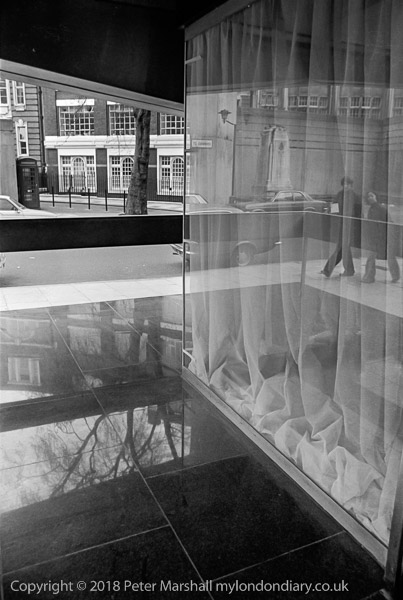
Whittington House, Chenies St/Alfred Place, Bloomsbury, Camden, 1978
14r23: camden, bloomsbury, reflection
A rather more interesting reflection image, making use of a reflection in both a vertical glass window and a horizontal polished marble floor, with careful lining up which makes the unusual near-horizontal strip fence around the office appear to continue seen through the window when it and the cars, buildings and the couple are in fact reflections. The corner where this picture was taken has since been altered.
The building was designed by Richard Seifert, also guilty for Centre Point, the Nat West Tower in the City, and many other 1960s and 70s eyesore buildings in London and elsewhere. What I called marble is probably the same highly polished black gabbro, a much harder basalt-like igneous rock, which also covers much of the face of this conspicuously ugly building. Gabbro gets its name from a town in Tuscany, but is found at many sites around the world, and the rock used on this building is from the Transvaal.
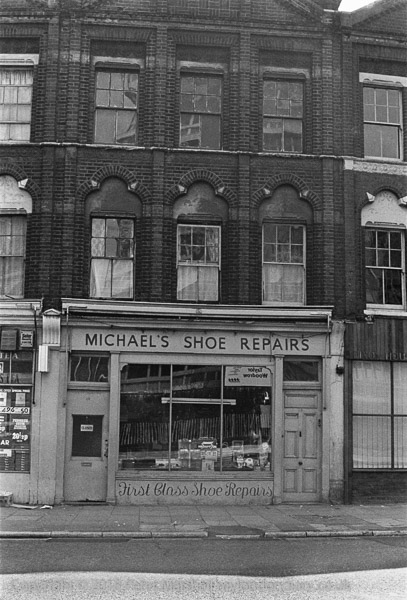
Michael’s Shoe Repairs, South Lambeth Rd, Vauxhall, Lambeth, 1978
14r53: vauxhall, lambeth, shoe repairs, shop
This is a part of a long parade of shops with accomodation above from the corner of Fentiman Rd, Barrett’s Corner, dated as 1884, and thought to have been built to house the workers from Barrett’s Brewery in Bondway, and also as wine and spirits vaults for the company.
The Vauxhall Brewery was designed by Henry Stopes (1852-1902) (father of Marie Stopes) in 1885, and unusually featured a 119 ft high tower which carried a large illluminated bottle advertising Barrett’s Half-Crown stout, 20ft long and 6ft in diameter, which was on roller bearings to rotate with the wind, and the taller chimney carried a giant screw bottle stopper at its 147ft high top. The brewery also had two giant beer bottles on the street flanking its Wandsworth Rd entrance, and it only produced bottled beer and closed in 1951.
The giant bottles had disappeared long before – perhaps when the factory was hit by a bomb from a Zeppelin in 1918 but some of the brewery complex remained, mainly as the Bondway Self-Storage but an attempt to get it listed failed and the Aykon 50 storey tower is being constructed on the site.
Not only is No 45 still standing (along with the rest of the row) but it is still Michael’s Shoe Repairs, though with an updated shop front.
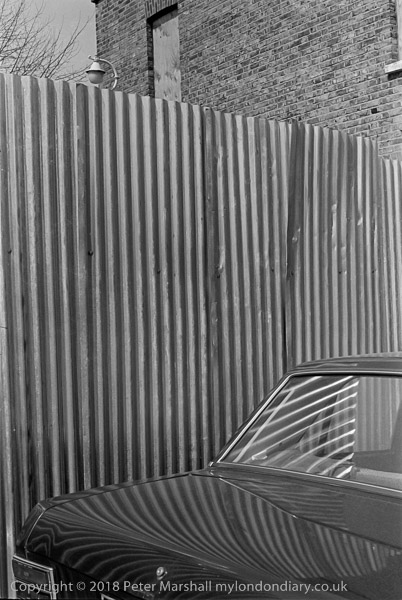
Parked car, Vauxhall, Lambeth, 1978
14r55: vauxhall, lambeth,car, reflection
Another image of reflections, somewhere in Vauxhall. The building behind the tall corrugated iron fence looks to be derelict and there is what appears to be a street lamp next to it, and I suspect this was in an area being redeveloped.
We used to go to a meeting with friends in Vauxhall most months and I would often go up an hour or so earlier than necessary to spend the time wandering the streets and taking a few pictures. I think this will have been taken between South Lambeth Road and Clapham Rd where the previous and next images were taken, but the location is hardly significant.
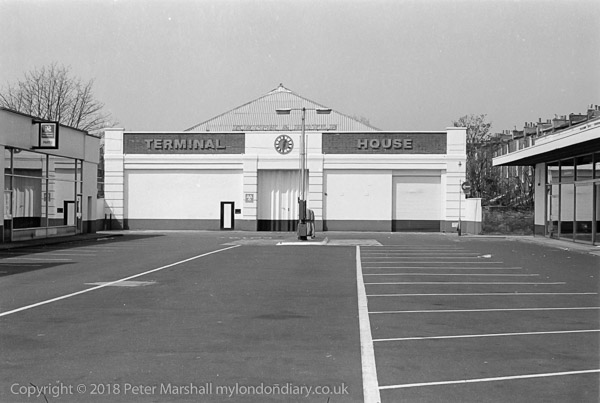
Terminal House, Clapham Rd, Kennington, Lambeth, 1978
14r62: kennington, lambeth, car dealer
Terminal House, then the premises of Vauxhall dealer Keith & Boyle, was at 80 Clapham Rd, or rather just set back from the road in Palfrey Place. It had been built in 1929 for use by Blue Belle Motors Ltd who ran services to the coast but opened as the London Terminal Coach Station, run by a specially created company, Coach Travels Ltd and used by Blue Belle and other coach companies. They sold it to Red & White Services Ltd in 1933 and it continued in use as a coach station until the start of the war in 1939 when the coach services were suspended, though it was never very successful, with most travellers preferring Victoria Coach Station for its more central location. But back in the 1930s the empty yard in the picture would be full of coaches ready to take people to Brighton and elsewhere.
Terminal House was an extremely long building, stretching the full 200m from Palfrey Place to Carroun Rd; it was rebuilt after war damage and used as car showrooms. Keith & Boyle ceased trading a few years after I took this picture and the main building has been demolished. The front of the site where I was standing to take pictures and some of the building to the side is now Europcar and main building has been replace by a new housing, Usborne Mews.
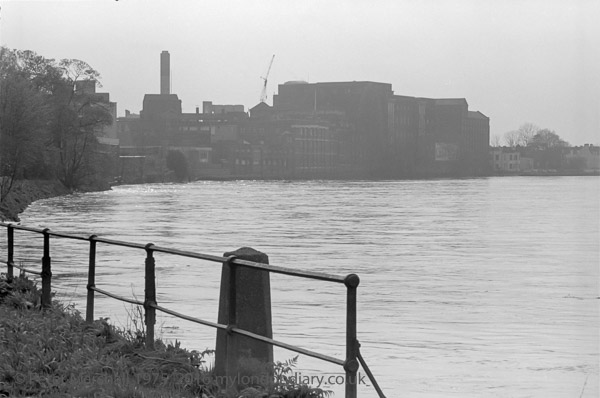
River Thames, Mortlake, Richmond, 1978
15a33: River Thames, Brewery, river
A little mist – or perhaps rain – over the Thames at Mortlake, close to where the annual University Boat Race between teams representing Oxford and Cambridge finishes, an event which doubtless gave plenty of extra sales for the products of Mortlake Brewery, founded in the 15th century and acquired by James Watney & Co in 1889. The brewery, which latterly produced Budweiser pale lager (a pale imitation of beer) for Anheuser-Busch InBev, finally closed in 2015 and the Singapore-based company that owns the site has plans for 850 apartments.
The picture was taken on a family outing to Chiswick Park, when we walked back over Chiswick Bridge and along the towpath on a roundabout walk to Mortlake Station. The Thames looks fairly calm, though it can get pretty choppy, and years later I watched as the Head of the River race (which rows the boat race same course but in the opposite direction and involves large numbers of boats dispatched at intervals) had to be abandoned as some boats sank a short distance behind where I took this picture going under Barnes Bridge.
The Boat Race is a curiously English event, showcasing some of the least healthy aspects of our class system, and one of the few moments of interest came in 2012 when Trenton Oldfield made his “protest against inequalities in British society, government cuts, reductions in civil liberties and a culture of elitism” swimming into the path of the race a mile or so downstream near Chiswick Eyot.
For which he got six months, a sentence many felt disproportionate, but which resulted in him publishing ‘The Queen Vs Trenton Oldfield: A Prison Diary’, sold to cover his court costs of £750 and described as “an insightful critique of the prison industrial complex at the the outset of the privatisation of prisons in Britain. Importantly, it also considers the criminalisation of dissent and reductions in civil liberties.” And it is still worth reading, although our prison system has sadly deteriorated since his stay in it.

River Thames, Twickenham, Richmond, 1978
15e34: River Thames, Eel Pie Island, boatyard, children, people
Children play on the mud in front of some of the boathouses on Eel Pie Island in what is perhaps a slightly distant view, though one that does include the surroundings more than if I had moved closer. The view today hasn’t changed greatly, though a closer look shows that the Thames Launch Works whose frontage states they are Ship and Boat Builders and Marine Engineers (though too small to read on this online version) has been replaced by a rather less impressive structure. The island, originally three separate islands, was consolidated into one as Twickenham Ait, but is now universally known as Eel Pie Island.
In my youth Eel Pie Island was noted for the Eel Pie Island Hotel, a musical venue where some of the most famous bands of the era including the Rolling Stones performed, but this had to close in 1967 when the owner couldn’t afford repairs. It had a brief re-opening in 1969 as Colonel Barefoot’s Rock Garden but was closed down as unsafe. It became home to the UK’s largest hippy commune and was then destroyed by a “mysterious” fire in 1971. It wasn’t the first fire on the island and there was another in 1996 that caused extensive damage. The hotel was on the opposite side of the island to my picture, and at around the time I took this was being replaced by a riverside development, Aquarius.
The Thames here is tidal, although a minimum water level is maintained by the half-lock at Richmond. Until 1957 when a footbridge was opened the only access to the private island was by boat; the footbridge was damaged by British Gas in 1997 and had to be replaced with a new bridge opening in 1998. At high spring tides the river comes up almost to the bottom of the balustrade at the left of my picture, and Twickenham riverside is flooded, rendering the footbridge inaccessible, so island residents need to keep a copy of the tide tables to hand to know when they can leave or access their homes.
I came to know it a little better when my younger son married a woman who had grown up on the island, in one of the modern houses that were built on the hotel site. They celebrated their wedding (which I photographed) at the Twickenham Rowing Club on the island, the third oldest rowing club on the Thames, founded in 1860. Until 1876 they had a floating boathouse which sank on several occasions.
The balustrade at left is on the edge of York House Gardens. King Louis Philippe I who came to England on his exile from France in 1848 with six sons and four daughters, and fourteen years after his death in 1850 they moved into York House in Twickenham, living there until around the end of the century. His fifth son, Henri, Duc D’Aumale (1822 – 1897) was Twickenham Rowing Club’s first President from 1860 to 1897, and presented them with the site on Twickenham Ait in 1876.
When my son visits Eel Pie Island he sometimes swims around the island, although until fairly recently there was a large red sign on a lamp post just behind where I took my picture with the message
‘WARNING
You are advised not to Swim or paddle in the Thames
Due to :
Submerged Debris
Strong Currents
Pollutants
Sudden Changes in Depth
DO NOT TAKE THE RISK’
This sign disappeared, along with a warning sign to drivers showing a car going over the edge when the lamp posts were replaced a few years ago by fake antique versions. Possibly now the river is a little less polluted than it was in my youth, though we used to swim in it back then.
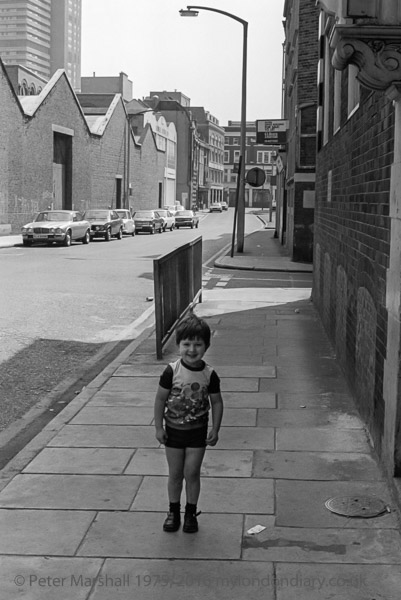
Child on street, Southwark, 1978
15j42: Southwark, children, people
This is one of eleven frames on the end of a roll of film which begins at home and suggests that I had set out walking from Waterloo Station. Several previous frames show Dolben St and Bear Lane, south of Southwark St, and I think this is taken on Unions St, outside the 1907 Shaftestbury Society ‘The Mint & Gospel Lighthouse Mission’, perhaps an appropriate place for this young boy who saw my camera and pleaded ‘Take my pictures, Mister’. I wonder if someone will see this picture and recognise themselves 40 years on.
The building is just before the corner of Redcross Way, and the tower at the left is Guy’s Hospital and the street at the end Borough High St, where the building on the corner of Newcomen St is still recognisable. The factory at left has been demolished and part of the site is now the Crossbones Graveyard, a medieval paupers’ burial ground and now a memorial site, but the rather distinctive works further down the street has been replaced by a rather mundane block which takes some motifs from the building in Maidstone Building Mews whose upper windows are visible here.
The Crossbones burial ground was closed in 1853 when it was “completely overcharged with dead” and was sold as a building site in 1883, prompting much local opposition, with the sale being declared null and void the following year. But much of the human remains were removed to Brookwood cemetery after which the site was built over. Part was needed for a substation for the Jubilee Line extension and in 1992 there was an archaeological dig in a small area which uncovered 148 graves dating from 1800-1853, a third being of perinatal children and another 11% under a year old. The adults were mainly women over 36. Deaths during childbirth were then common, and older women were at greater risk. Southwark at that time was probably one of the most unhealthy areas of the country and it is thought that these represent a very small percentage of the bodies still underground.
The unconsecrated graveyard was thought to have been established for the prostitutes or “Winchester Geese”, women licensed by the Bishop of Winchester to work in the Liberty of the Clink, though later it was simply a pauper’s graveyard for St Saviour’s parish. Writer John Constable, also known as urban shaman John Crow, produced ‘The Southwark Mysteries’, plays and poems inspired by the site, and the Friends of Cross Bones hold monthly vigils in the memorial garden, with a larger event at Halloween.
More to follow….
______________________________________________________
There are no adverts on this site and it receives no
sponsorship, and I like to keep it that way. But it does take a considerable amount of my time and thought, and if you enjoy reading it, a small donation – perhaps the cost of a beer – would be appreciated.
My London Diary : London Photos : Hull : River Lea/Lee Valley : London’s Industrial Heritage
All photographs on this and my other sites, unless otherwise stated, are taken by and copyright of Peter Marshall, and are available for reproduction or can be bought as prints.
To order prints or reproduce images
________________________________________________________